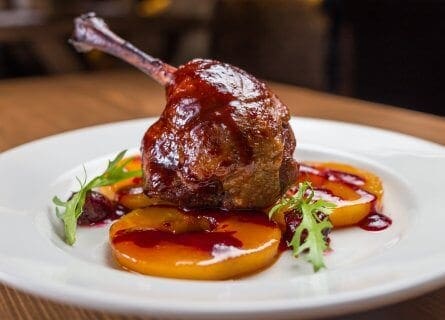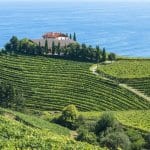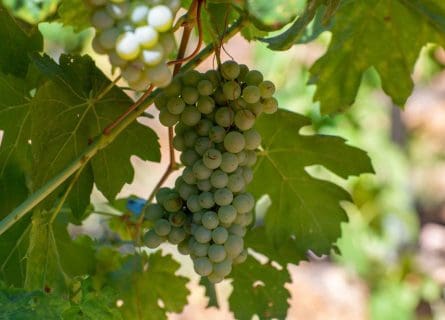
Biarritz Travel Guide
Biarritz Brilliance: Surf, Sand, and the Sophistication of the Basque Coast
Biarritz is one of France’s most beautiful and stylish cities, located a mere stone’s throw away from Spain and yet proudly independent from France as a Basque city! The capital of the French Cote Basque seaside region, visitors always fall head over heels and succumb to the city’s elegant allure within hours of arriving. They are drawn to the stunning beaches, the surf, the golf, the nightlife, and the excellent cuisine. Add into the mix a warm, benign summer climate and some of the most spectacular scenery in Europe, and it’s not hard to see why tourists regard Biarritz as a cut above.
What we know today as a vibrant city and seaside resort began life as a small fishing village. This settlement existed almost solely due to its favorable Atlantic coast position. The settlement, founded by the local Basque inhabitants, was conquered by the Romans in the 1st Century. Quickly sensing the region’s potential, the Romans baptized the South West of France as Aquitania or Aquitaine. The area remained under Roman control for centuries, prospering as a fishing village and small trading port.
However, as the Roman Empire began to crumble in the 5th Century, they lost control of the region. In 418, Rome gave the provinces of Aquitania to the Visigoths, tribes from Northern Europe. A period of conflict followed, with several tribes fighting to control this desirable part of France. In the Middle Ages, the village became known as a whaling base – the Visigoths eventually lost to the Francs.
The Francs would struggle to hold on to their prize, as the Vikings also had their eyes set on conquering Biarritz. The Vikings traveled up the French River Garonne, finally conquering Biarritz in 840 during their invasion of Gascony. Interestingly, the settlement’s name would change several times, from Bearriz in 1170 to Bearids sixteen years after. Finally, its rulers settled on the title Biarritz in 1249. The Vikings established a lucrative whaling trade, and ships would depart daily from Biarritz. The village grew into a prosperous town, although somewhat unfortunately on the back of whale hunting.
The Viking rule over Biarritz endured until 982 when the Basque Duke William II Sanchez of Gascony overcame them. He drove out the Scandinavian invaders and reintroduced Christianity to the region; monasteries soon sprung over all over this part of the Basque country. However, Biarritz was only briefly under the Duke’s control; despite his best efforts, the territory of Gascony had split into different feudal kingdoms. Biarritz suffered from a lack of unified control and faded into obscurity for a time despite its importance as a fishing and trading port.
By the Middle Ages, Biarritz had fallen indirectly into English control after Eleanor of Aquitaine married Henry II of England, giving him possession of the French territories of Aquitaine and Gascony. In the 13th Century, Biarritz was ruled by Simon de Montfort, whom Henry III appointed as Governor of Gascony. His short and often capricious rule was highly unpopular with the city’s inhabitants; in August 1252, Henry III formally relieved him of his command. A period of unrest and turbulence would follow; during the 100-year war, the French King Philip IV would battle Edward I for control of the region. Philip kept control until the Treaty of Paris in 1303; after that, it was part of the English throne.
Although Biarritz was formerly part of Edward’s first Kingdom, a strong degree of cultural independence and, at times, solidarity with England rather than France developed over the centuries. Unlike the French, the Basque inhabitants showed a favorable attitude towards Protestantism. The printing of books in Basque, mostly on Protestant Christian themes, was introduced in the 16th Century by Bayonne’s Basque-speaking residents. However, Roman Catholics in France persecuted the residents of cities like Biarritz for their beliefs. The future French King Henry IV was drawn from the Basque country, converting to Roman Catholicism in the 16th Century.
Basque Provinces and cities like Biarritz enjoyed a great deal of self-government despite being formerly under French control until the French Revolution in the 18th Century. Biarritz had prospered under a reasonable level of self-determination. Still, the French Revolution and subsequent abolition of the monarchy centralized the government and abolished the local privileges granted by the so-called ancient regime. However, during the French Revolution, the region was one of the few tranquil areas during these turbulent times and largely escaped the fighting and conflict.
The city’s golden age and renown as a desirable resort for Europe’s elite came in the mid-19th Century. Biarritz was placed firmly on the map when Empress Eugenie, the wife of Napoleon III, built a summer palace on the beach in Biarritz. Today, the palace forms the beautiful Hotel du Palais, which attracts visitors far and wide in search of glamour. Biarritz became the preferred vacation spot of European royalty, such as Queen Victoria and Alfonso XIII of Spain.
The city greeted the 20th Century with jubilation; in 1901, Biarritz’s now-famous casino opened. Its clean, unspoiled coastal scenery and beaches turned the city into a tourist magnet for wealthy Europeans and a sizeable majority of Americans. It became a prime destination for surfers worldwide, with a corresponding development in nightlife and infrastructure. Times had never been so good for Biarritz.
Sadly, the advent of the Two World Wars would bring hardship to its citizens; many young French men would never return home during the 1st World War. Although Biarritz escaped the direct conflict of World War Two, the region came under Nazi control, and the entire Atlantic coastline was declared a military zone, placing it off-limits to French civilians (except for local inhabitants, who required a special pass). After the war ended, the city became famous for becoming a U.S. Army university base. Under General Samuel L. McCroskey, Biarritz’s hotels and casinos were converted into quarters, labs, and class spaces for U.S. service personnel. The University opened on the 10th of August 1945, and approximately 10,000 students attended an 8-week term. This campus was set up to provide a transition between army life and subsequent attendance at a university in the USA, a unique project in Europe.
Biarritz recovered from the war years to emerge as France’s premier seaside resort, a position it has maintained into the 21st Century. It is easily accessible from Paris via the TGV, and as a result, the city is buzzing and packed with visitors through the summer. Much of its appeal lies in the Basques, who have maintained their language and culture over the decade. Add to that the legendary Basque talent for gastronomy, a vibrant nightlife, and stunning scenery courtesy of the French Pyrenees, and it’s not hard to see why the same faces return every year. Welcome to Biarritz, the pearl of the Basque coast! And while here, you can hop across the border to visit San Sebastian, Hondarribia, and Getaria– all beautiful foodie towns.
-

Duck confit, typical dish in Biarritz bistros Gastronomy & Wine
The French take two things very seriously, and the citizens of Biarritz are no exception. Likewise, its Basque inhabitants take gastronomy exceptionally seriously, and some of the finest French cuisine resides in the Basque region.
Like every French city, Biarritz has an enormous variety of places to eat and drink. Street cafes are ideal for a drink and a snack throughout the day. Simultaneously, the abundance of typical Bistros, serving the staples of confit of duck and rib-eye steaks accompanied by the Legendary frites, offer something more substantial. Biarritz brims with every type of restaurant, small family business, Michelin-starred venues, and formal hotel venues. The best restaurant district is the old port, a hidden gem of wooden fishing cottages and fresh seafood. Try Casa Juan Pedro for superb, fresh fish caught daily.
Local Basque cuisine is always based on high-quality, local ingredients in season rather than elaborate sauces or spice combinations. The Basque people have a long maritime history, and the fish here is unbeatable. Cod, hake, and fresh tuna are popular when the Oysters are in season. They sell out fast! Wild game, hams, and mushrooms are all popular staples of local cuisine.
Irouléguy is the local appellation located around St. Jean Pied de Port’s pilgrimage hamlet, making white and light red wines. The grapes used are in Euskara (the Basque language), and red varietals include Bordelesa Beltza, which means Black Bordeaux and is the Tannat grape also used in Madiran; Axeria Handia (Cabernet Sauvignon) and Axeria (also known as Cabernet Franc). White varietals include Xuri Zerratia, Izkiriota (Gros Manseng as it is called in Jurançon), and Izkiriota Ttipia (Petit Manseng in Jurançon). Across the border, the (Spanish) Basque country produces Txakoli, a crisp white wine perfect as an aperitif. The (Spanish) Basque region of Álava also produces exceptional red Rioja wines, perfect for the local game and lamb dishes. Cider is also very big here. You can visit and dine at many local cider houses on both sides of the border.
Gastronomy Guide to Basque Country: Read more
Nearby Wine Regions
-
 Embark on a sensory journey through Basque Wine Country, exploring its rich terroir and exquisite vintages. Plan your trip today! Read more
Embark on a sensory journey through Basque Wine Country, exploring its rich terroir and exquisite vintages. Plan your trip today! Read more
Highlights
-
Miremont
Biarritz’s most famous social venue has been going since 1880. It dates back to the time when Belle-époque Biarritz was simply the beach resort of choice for the rich and famous of Europe. Today it still attracts the great and the good, but all are welcome to enjoy a fine selection of teas, cakes and spectacular views over the bay.
-
Musée de la Mer
One of the best aquariums in Europe, the sea museum, is housed in a beautiful art deco building. Biarritz’s Musée de la Mer is teeming with underwater life from the Bay of Biscay and beyond, as well as exhibits on fishing recalling Biarritz’ whaling past. It’s the seals that steal the show though (feeding time, which is always a favorite with children, is at 10.30 am and 5 pm). Unmissable if you take the kids!
-
Parc National des Pyrénées
This stunning area of natural beauty is easily accessible from Biarritz and extends 100 KM along the French-Spanish frontier. It boasts some of the most splendid alpine scenery in Europe and is rich in animal and plant-life. There are over 350KM of footpaths within the park, making it very visitor friendly—an outdoor lovers’ dream.
-
St-Jean-de-Luz
A short distance south of Biarritz, St-Jean-de-Luz is the most quaint and delightful fishing village that explodes into life in the summer. A walk along the bustling sea-front is a real pleasure; make sure also to visit the Eglise St-Jean Baptiste. This was the sight of Louis XIV’s marriage to the Infanta Maria Teresa of Spain in 1600.
Recommended for you
More information
If you would like us to customize an exclusive luxury tour, contact us and let us know your travel plans. We offer luxury food and wine tours for private groups of a mininium two guests. In addition, all of our private, chauffeured tours are available year-round upon request.














